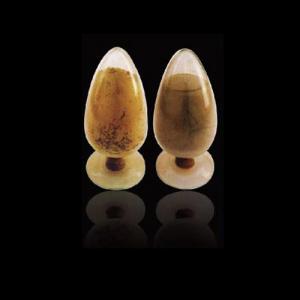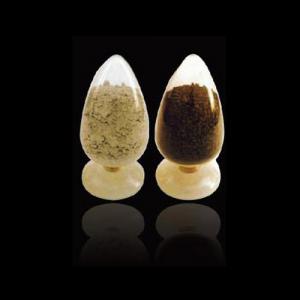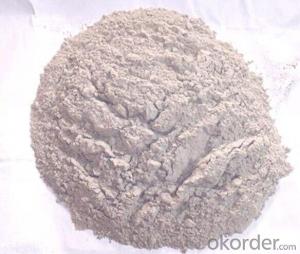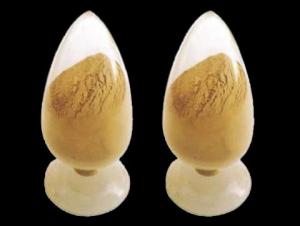Castable for Iron and Steel
- Loading Port:
- China Main Port
- Payment Terms:
- TT OR LC
- Min Order Qty:
- -
- Supply Capability:
- -
OKorder Service Pledge
OKorder Financial Service
You Might Also Like
General Information
CMAX Monolithic Refractories for Blast Furnace including Al2O3- SiO2-C castable for blast furnace tapping channel, alumina-spinel castable for ladle and high-alumina plastic castable. Made as per international standards, our product is known for its excellent corrosion and scouring resistance of iron steel, long operating life and easy execution and mending. Further, these can be provided in different specifications as required by the clients.
Feature
Excellent corrosion and scouring resistance of iron steel
Long operating life
Easy execution and mending
Application
Main ditch of molten iron line
Main ditch of slag line
Iron trough
Slag trough
Linings of ladle (Vibration casting method construction
Linings of heating furnace of steel rolling, incinerator (Ramming construction method)
- Q:How do monolithic refractories withstand high temperatures and thermal cycling?
- Monolithic refractories are designed to withstand high temperatures and thermal cycling due to their unique composition and structural characteristics. Firstly, monolithic refractories are made from high-quality raw materials, such as alumina, silica, and magnesia, which have excellent thermal properties. These materials possess high melting points and low thermal conductivity, allowing them to retain their strength and integrity even at extreme temperatures. Moreover, monolithic refractories are typically engineered to have a dense and compact microstructure. This dense structure prevents the penetration of heat and gases, thus minimizing thermal shock and preventing the formation of cracks. Additionally, the compact microstructure enhances the refractory's thermal conductivity, enabling it to efficiently distribute and dissipate heat. Furthermore, monolithic refractories are often formulated with special additives and bonding agents that enhance their resistance to thermal cycling. These additives can improve the refractory's thermal expansion properties, allowing it to expand and contract without cracking or spalling during rapid temperature changes. Additionally, certain bonding agents can provide a degree of flexibility to the refractory, enabling it to accommodate thermal stresses without compromising its structural integrity. In addition to the inherent characteristics of monolithic refractories, proper installation techniques also play a crucial role in their ability to withstand high temperatures and thermal cycling. The refractory must be carefully applied and cured to ensure uniformity and minimize the formation of internal stresses. Adequate curing and heat treatment processes help to develop a strong and durable bond between the refractory and the substrate, enhancing its resistance to thermal shock and cyclic thermal loading. Overall, monolithic refractories are engineered to withstand high temperatures and thermal cycling through their composition, microstructure, and installation techniques. These factors work in synergy to provide the refractory with excellent thermal conductivity, resistance to thermal shock, and the ability to expand and contract without compromising its structural integrity.
- Q:How do monolithic refractories improve energy efficiency in the iron and steel industry?
- Monolithic refractories play a crucial role in improving energy efficiency in the iron and steel industry through various mechanisms. Firstly, these refractories have excellent insulation properties, which help in reducing heat loss during the production process. By minimizing heat loss, monolithic refractories ensure that more heat is retained within the furnace, resulting in higher energy efficiency. Moreover, monolithic refractories have low thermal conductivity, allowing for better heat transfer within the furnace. This means that the heat generated during the production process can be efficiently distributed throughout the furnace, enabling optimal temperature control and reducing energy wastage. In addition, monolithic refractories have high resistance to thermal shock and corrosion, which are common challenges in the iron and steel industry. By withstanding extreme temperatures and chemical reactions, these refractories prevent premature wear and tear, thus reducing the need for frequent repairs and replacements. This not only saves energy but also minimizes downtime, leading to increased productivity and energy efficiency. Furthermore, the use of monolithic refractories allows for better furnace design and optimization. Their flexibility enables the creation of custom shapes and linings that suit specific furnace requirements, resulting in improved heat transfer and combustion efficiency. This customized approach promotes energy savings by maximizing the utilization of fuel and reducing emissions. Lastly, monolithic refractories have a longer lifespan compared to traditional brick refractories. This prolonged durability reduces the frequency of refractory replacements, resulting in lower energy consumption associated with the manufacturing and installation of new refractories. Overall, monolithic refractories contribute significantly to energy efficiency in the iron and steel industry by reducing heat loss, improving heat transfer, withstanding thermal shock and corrosion, enabling better furnace design, and increasing refractory lifespan. Their use not only saves energy but also enhances productivity and sustainability within the industry.
- Q:What are the specific requirements of monolithic refractories for steel ladle purging applications?
- To ensure optimal performance and durability, monolithic refractories used in steel ladle purging applications must meet certain requirements. Firstly, they need to possess high thermal stability and resistance to thermal shock, as the steelmaking process involves extreme temperatures. This is crucial in order to prevent any cracking or spalling of the refractory lining. Additionally, monolithic refractories used for ladle purging applications should exhibit excellent corrosion resistance against molten steel and slag. They must be able to withstand the aggressive chemical environment without experiencing significant deterioration, as this could lead to contamination of the steel and negatively impact its quality. Another essential requirement is good erosion resistance. The refractories should be capable of withstanding the high velocity of the purging process, which involves the injection of argon or other gases into the ladle to remove impurities. This erosion resistance ensures that the refractory lining remains intact and does not wear away during operation. Furthermore, monolithic refractories for ladle purging applications should have low porosity and high density. This prevents the infiltration of molten steel and slag into the refractory lining, thus reducing the risk of thermal spalling and corrosion. Lastly, these refractories should exhibit good thermal conductivity in order to efficiently transfer heat from the steel to the refractory lining. This allows for better temperature control and energy efficiency during the purging process. Overall, the specific requirements for monolithic refractories in steel ladle purging applications include high thermal stability, corrosion resistance, erosion resistance, low porosity, high density, and good thermal conductivity. Meeting these requirements ensures that the refractories can withstand the harsh conditions of the steelmaking process, maintain their integrity, and contribute to the production of high-quality steel.
- Q:How are monolithic refractories installed and repaired in iron and steel plants?
- Monolithic refractories in iron and steel plants are typically installed through a process called gunning, where a specialized gunning machine is used to spray the refractory material onto the desired surface. The refractory material is mixed with water or a bonding agent to form a dense and durable lining. In terms of repairs, damaged or worn-out monolithic refractories are typically removed by mechanical means, such as jackhammers or pneumatic tools. The damaged area is then cleaned and prepared before new refractory material is applied using the gunning method. In some cases, patching materials may be used to repair smaller areas of damage. Overall, the installation and repair of monolithic refractories in iron and steel plants require skilled technicians and specialized equipment to ensure the optimum performance and longevity of the refractory lining.
- Q:How do monolithic refractories contribute to energy efficiency in the iron and steel industry?
- Various mechanisms are employed by monolithic refractories to enhance energy efficiency in the iron and steel industry. The first mechanism is their exceptional thermal insulation properties, which minimize heat loss from furnaces and high-temperature equipment. This efficient utilization of heat generated during production leads to significant energy savings. Another important feature of monolithic refractories is their ability to withstand rapid temperature changes without cracking or spalling, known as thermal shock resistance. This quality is crucial in an industry where extreme temperature variations are common. By maintaining their structural integrity, these refractories prevent heat leakage and ensure effective energy utilization. Furthermore, monolithic refractories contribute to energy efficiency by reducing downtime and improving operational efficiency. Their easy installation and repair result in shorter maintenance cycles, minimizing the time required for furnace maintenance. This allows for continuous operation and uninterrupted energy utilization. Additionally, their high durability reduces the need for frequent replacements, further enhancing energy efficiency by reducing material and energy waste associated with regular repairs. In conclusion, monolithic refractories play a significant role in enhancing energy efficiency in the iron and steel industry. Their properties, such as thermal insulation, thermal shock resistance, and ease of installation and repair, ensure effective energy utilization and substantial energy savings. Improved operational efficiency and reduced downtime further contribute to overall energy efficiency.
- Q:How do monolithic refractories resist thermal shock in the iron and steel industry?
- Monolithic refractories in the iron and steel industry resist thermal shock primarily due to their ability to absorb and distribute thermal stress. These refractories are composed of a single, continuous structure, eliminating the weaknesses inherent in jointed or layered materials. Their dense and homogeneous structure allows for efficient heat transfer and expansion, minimizing the risk of cracking or spalling caused by sudden temperature fluctuations. Additionally, monolithic refractories possess high thermal conductivity, which aids in dissipating heat and preventing localized hotspots. Overall, their resilience to thermal shock makes them ideal for withstanding the extreme conditions of the iron and steel manufacturing processes.
- Q:How do monolithic refractories enhance the performance of ladle and tundish preheating systems?
- Monolithic refractories enhance the performance of ladle and tundish preheating systems by providing excellent thermal insulation, high mechanical strength, and resistance to corrosion and erosion. This allows for efficient heat retention and distribution, ensuring uniform and consistent preheating of ladles and tundishes. Additionally, monolithic refractories minimize heat losses, reduce energy consumption, and increase the lifespan of the preheating systems, contributing to improved overall performance.
- Q:How do monolithic refractories resist corrosion from molten metals?
- Monolithic refractories resist corrosion from molten metals due to their inherent chemical composition and physical properties. These refractories are made using high-quality materials that possess excellent resistance to chemical attack and high temperatures. They are designed to have a dense and compact structure, which helps in preventing the penetration of molten metals and minimizing the reaction between the refractory and the metal. Additionally, monolithic refractories often contain additives or binders that enhance their resistance to corrosion, making them highly effective in withstanding the aggressive nature of molten metals.
- Q:What are the recommended storage and handling practices for monolithic refractories?
- The recommended storage and handling practices for monolithic refractories include storing them in a dry and covered area to prevent moisture absorption, avoiding direct contact with the ground to prevent contamination, and ensuring proper ventilation to prevent condensation. It is important to handle them with care, avoiding dropping or hitting them, and using appropriate lifting equipment when necessary. Additionally, following the manufacturer's guidelines for installation, curing, and drying processes is crucial to ensure optimal performance and longevity of the monolithic refractories.
- Q:How do monolithic refractories withstand the chemical attacks in copper smelting applications?
- Due to their unique properties and composition, monolithic refractories are capable of enduring chemical attacks in copper smelting applications. These refractories are specifically engineered to resist the harsh and corrosive environment found in copper smelting processes. To begin with, monolithic refractories are crafted from high-quality materials such as alumina, silica, and magnesia. These materials possess high melting points and chemical stability. Carefully selected, they are able to withstand the corrosive effects of copper smelting, including the presence of sulfur compounds and acidic gases. The refractory's composition also includes various additives and bonding agents that enhance its resistance to chemical attacks. In addition, monolithic refractories exhibit exceptional thermal shock resistance. This means they can withstand rapid temperature changes without cracking or spalling. In copper smelting applications, where extreme temperatures are involved, this refractory quality is crucial in preventing the formation of cracks and ensuring long-term performance. Furthermore, monolithic refractories possess a dense and compact structure. This structure serves as an effective barrier against the infiltration of molten copper and other corrosive substances. By preventing the penetration of chemical attacks, the refractory lining's durability and longevity are ensured. Moreover, monolithic refractories offer superior erosion resistance. This is particularly important in copper smelting applications, where high-velocity gases and flows of molten metal can cause erosion of the refractory lining. The refractory's erosion resistance prevents the degradation of the lining and maintains its structural integrity. In conclusion, monolithic refractories are specially designed to withstand the chemical attacks encountered in copper smelting applications. Through the use of high-quality materials, the incorporation of additives, and the possession of excellent thermal shock resistance, density, and erosion resistance, these refractories provide a reliable and durable lining that can endure the harsh conditions of copper smelting processes.
1. Manufacturer Overview |
|
|---|---|
| Location | |
| Year Established | |
| Annual Output Value | |
| Main Markets | |
| Company Certifications | |
2. Manufacturer Certificates |
|
|---|---|
| a) Certification Name | |
| Range | |
| Reference | |
| Validity Period | |
3. Manufacturer Capability |
|
|---|---|
| a)Trade Capacity | |
| Nearest Port | |
| Export Percentage | |
| No.of Employees in Trade Department | |
| Language Spoken: | |
| b)Factory Information | |
| Factory Size: | |
| No. of Production Lines | |
| Contract Manufacturing | |
| Product Price Range | |
Send your message to us
Castable for Iron and Steel
- Loading Port:
- China Main Port
- Payment Terms:
- TT OR LC
- Min Order Qty:
- -
- Supply Capability:
- -
OKorder Service Pledge
OKorder Financial Service
Similar products
New products
Hot products
Related keywords


























